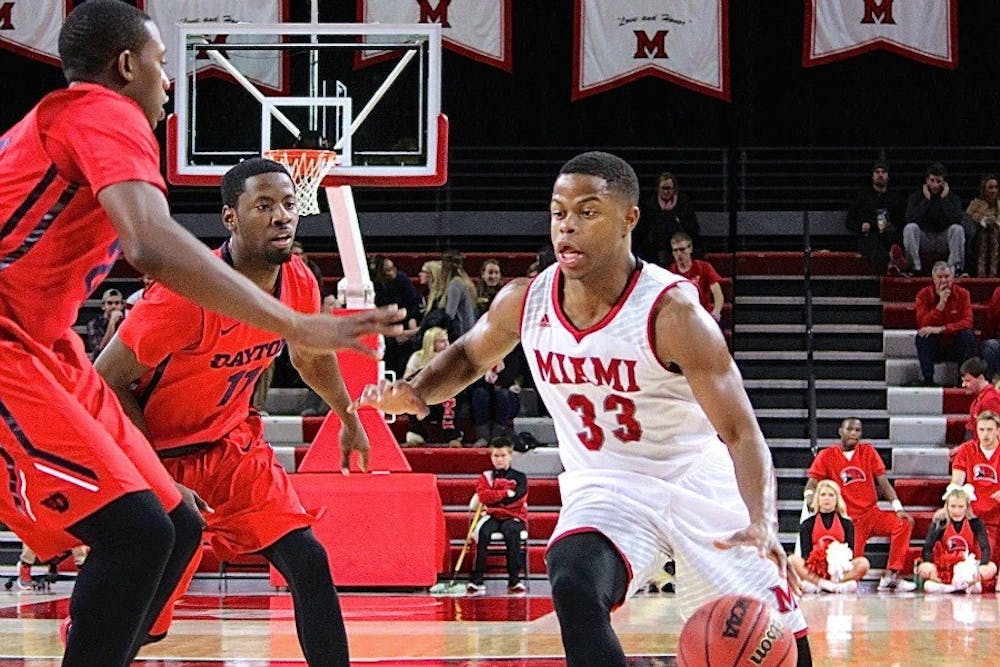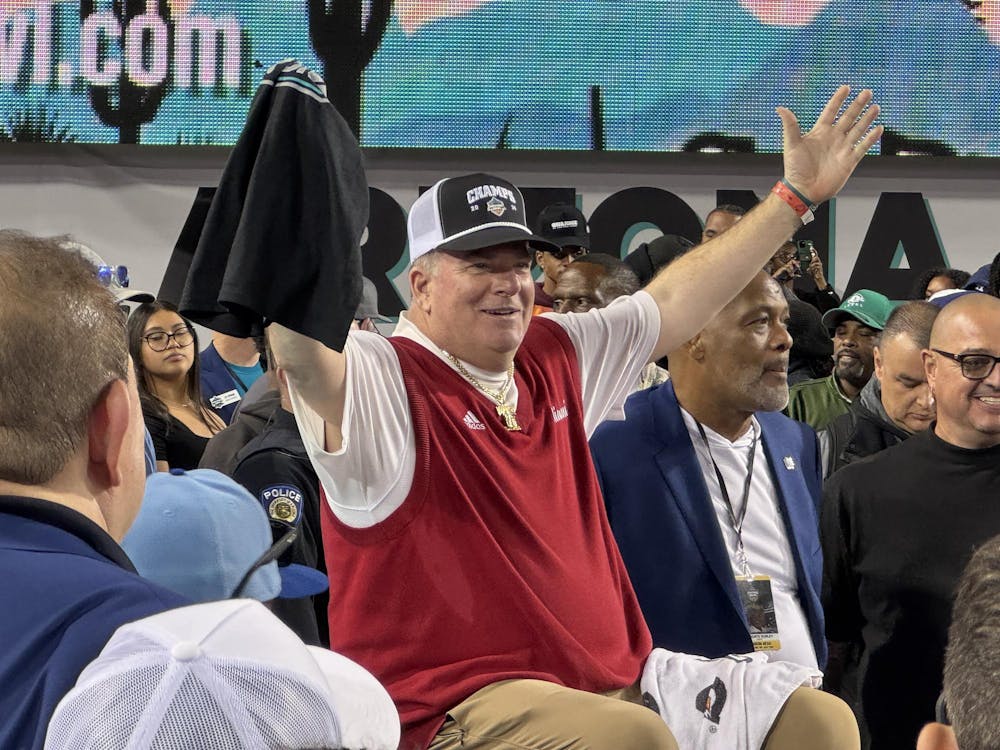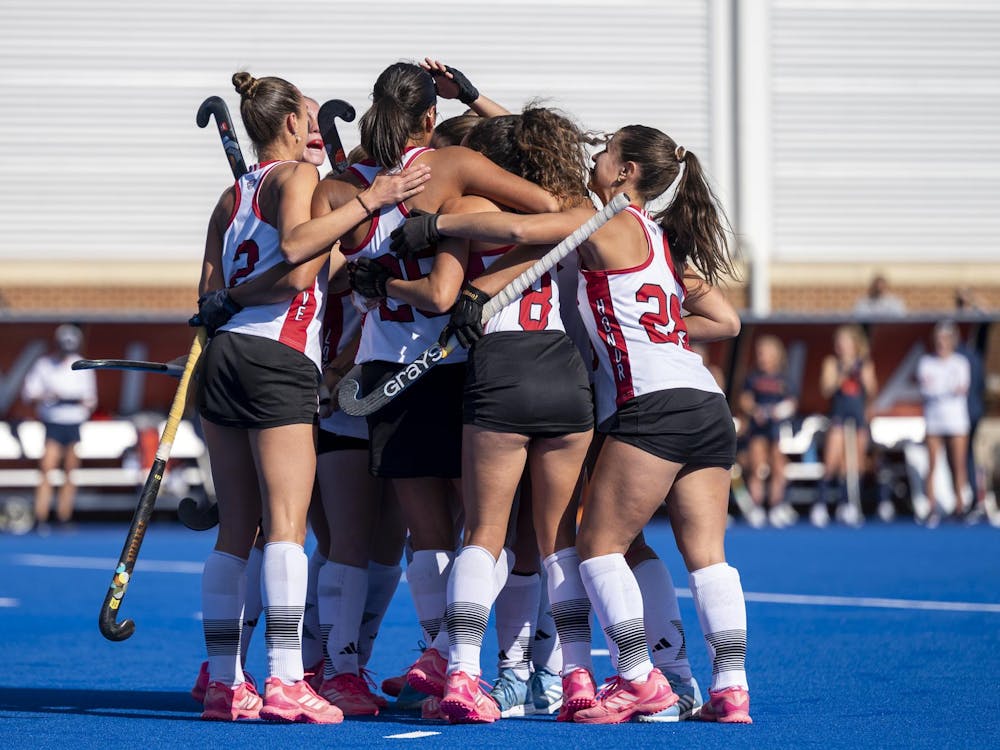By Jack Reyering, For The Miami Student
Imagine this:
With 3:09 left in the game, your home team is down by 12 to their in-state rivals. Using full court traps, staunch defense and several clutch shots, your team cuts the deficit to two points with 1:08 left to play in the game.
After trading free throws for the next 50 seconds, your team trails by three points with 16.2 seconds to go. The opponents increase the lead to four, making it a two-possession game.
Down two points with just 7.4 seconds to go, a home team player snares the rebound on a missed free throw and passes the ball up the court to his teammate. He dribbles once, hangs in the air and lays the ball up and in over the defender to force overtime.
Your team dominates the overtime period and completes one of the wildest comebacks in recent history.
It's a great story with a thrilling end - the type of game people discuss non-stop during the following days, the kind of game boys who dream of playing college basketball recap over and over in their heads, replacing themselves as the hero.
But this game wasn't imagined. It happened right here in our own backyard. And this is probably the first time you've heard of it.
This scenario came to life in Millett Hall during this past men's basketball season.
When that final buzzer sounded on Feb. 24, the Miami University men's basketball team had just capped off an overtime win on the shoulders of a furious 19-point comeback over rival Kent State University.
The title of the game recap on Miami's athletics site is dubbed "Miracle in Millet." The title seems appropriate to those who closely follow RedHawk basketball. The problem is, few people do.
While the players celebrated on the court, only 920 fans celebrated in the stands. This is not a relatively small crowd for the Miami basketball team. When the 2014-15 season ended March 9th, the average attendance for home games was just 1113. In the Mid-American Conference, a league of 13 teams, only Eastern Michigan University had lower attendance rates.
Enjoy what you're reading?
Signup for our newsletter
The men's basketball team is not the only RedHawk sports team to have this problem. Outside of the men's hockey team, nearly every other major Miami sports team suffers poor attendance rates.
The question is why are Miami athletics so poorly attended? Who or what is to blame? The students? The teams? This question probably doesn't have definite answer.
It's difficult and simply unfair to blame students for not showing up to sporting events. Teams around the country who consistently draw large crowds have done so by mastering this very simple formula: team + wins = attendance.
Miami has had successful sports teams in the past.
The football program is marked by a history of exceptional coaches who have gone on to be some of the most successful, influential and winningest figures in NCAA history. Legends like Woody Hayes and Bo Schembechler began their careers in Oxford. Ben Roethlisberger and John Harbaugh called themselves RedHawks during their college careers and went on to find great success in the NFL.
The basketball program has also had successful campaigns. The 'Hawks total 17 NCAA tournament appearance. Ron Harper and Wally Szczerbiak played for the RedHawks and continued their careers in the NBA.
When the Miami has good sports teams, the fans come out to watch them play.
The 1998-99 campaign was arguably the best season for the men's basketball program in Miami history. Led by senior Wally Szczerbiak, they went 24-8 on the season and landed a No. 10 seed in the NCAA Tournament. The RedHawks went on an improbable tourney run, advancing to the Sweet 16 for the first and only time in school history. During that season, Millett Hall averaged an attendance rate of 6,401 per home game (Millet has a capacity of 9,100).
The football program too has shown the ability to draw crowds when the team is winning. The 2003 team, led by senior quarterback Ben Roethlisberger, averaged 25,132 fans at their five home games on the season. At the time, the capacity of Yager Stadium was only 24,286, meaning the stadium was stuffed with nearly 1,000 more fans than it was capable of holding. That team went 13-1 overall and 8-0 in the MAC, including a bowl win over Louisville.
Neither of these teams went on to sustain the success they found during these seasons. Since their Sweet 16 run, the basketball team has returned to the tournament one time. The football team has been to two bowls since the 2003 season, most recently in 2011.
To say the least, current students on Miami University's campus are far removed from any real success by either of these sports programs.
Since these sports programs haven't been winning, students haven't been attending. These statistics demonstrate that in isolated seasons both of these teams have had success and drawn crowds - key word being "isolated". To put it plainly, the past shows Miami students are not excited enough about Miami athletics to show up for a losing team.
So if we aren't at the games, where are the Miami students? The largest congregation of students on college football game days converge at bars in uptown Oxford. The number of students wearing Lebron James jerseys alone outnumbers Miami football jerseys. Groups of guys gather around TVs to watch Ohio State, Michigan State and Notre Dame. They talk about who will make the college football playoffs, and Miami football rarely enters the conversation.
Miami attracts students from across the country for many reasons. But ask any student on campus their top three reasons for coming here and you will struggle to find someone who cites the sports teams as a major influence.
Instead, we bring our home-grown sports alliances to Oxford. We ask the bartender to change over to the Cavaliers/Blackhawks/Buckeyes game. We wear our coolest throwback basketball jersey before preseason games have even started. We give our friends hell when their team loses a game called "a guaranteed win" three hours ago.
That is the reality of Miami sports culture, and maybe there's nothing wrong with that. After all, you probably didn't choose to go here for the sports teams, and not every school can sustain the level of sports excellence schools like Duke and Alabama have. Miami football and basketball are probably a long ways away from becoming powerhouses.
So keep your hometown alliances. Cheer for the winning teams that you have followed since you were a kid.
But, maybe go to a Miami football game one week. Go to a tailgate before kickoff. Catch a basketball game on a boring weekday evening. If you have no allegiance either way, what do you have to lose?
Just picture yourself at Millett Hall witnessing a game like that. What a memory that would have been.




